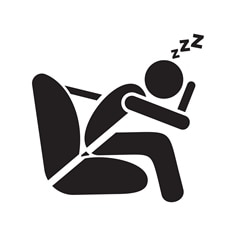The Risks of Drowsy Driving are Real and Severe
While many people would never consider driving after drinking alcohol or taking drugs, many commercial vehicle operators don’t think twice about driving fatigued. This is especially dangerous, as the drivers may not even realize the risks to which they are exposing themselves and other drivers. The unsafe behaviors associated with drowsy driving include:
- Slow reaction time.
- Poor judgment.
- Inability to focus on the task of driving.
- Increased irritability and aggressive driving.
- Decreased awareness of surroundings.
Additionally, when a driver is so tired he falls asleep behind the wheel, devastating accidents can occur. The loss of control of a truck can lead to all types of dangerous crashes, including rollovers, rear-end crashes, head-on collisions, and more. When these crashes occur, they nearly always have more serious consequences for the passengers of the smaller vehicles. In fatal two-vehicle crashes involving large trucks in 2015, the occupants in the passenger cars were killed 97 percent of the time.
Federal Rules Mandate Rest for Commercial Drivers
In an effort to increase the safety of everyone, the Federal Motor Carrier Safety Administration (FMCSA) has set certain rules that drivers are to obey regarding how long they may drive. These rules include:
- 11 Hour Driving Limit – Operators can drive for a maximum of 11 hours after 10 consecutive hours off duty.
- 14 Hour Driving Limit – Operators cannot drive after the 14th consecutive hour after coming on duty, even if they have not reached the 11 hours of drive time. Rest breaks do not extend this time.
- Rest Breaks – Drivers must take at least a 30-minute break every eight hours.
- 60/70 Hour Restart – Drivers may not be on duty for more than 60 or 70 hours in a consecutive six- or seven-day period. The clock will restart after the driver has been off duty for at least 34 hours.
However, facing pressure from employers and consumers alike to deliver goods as quickly as possible, commercial drivers will often ignore these rules and continue to operate their vehicles well past the appropriate time. Hours of service violations were among the most common offenses reported in roadside inspections in 2015, with over 43,000 violations noted.
Identifying Fatigued Drivers Can Be Difficult
Many experts agree that the instances of drowsy driving are vastly underreported. These cases are often challenging for a few key reasons, including:
- No roadside test exists for drowsy driving. Unlike a breathalyzer or blood test, there is no way to be sure that a driver is too fatigued to be behind the wheel.
- Reporting practices are inconsistent. Law enforcement has little training in recognizing drowsy driver, and every state addresses the issue differently.
- Self-reporting is unreliable. Often, a driver does not even realize he fell asleep or that his drowsiness caused the crash.
- Fatigue can be associated with other crash causes. In some cases, fatigue can play an important role in an accident that has other significant factors, including alcohol or drug use or distraction.
However, an experienced truck accident attorney can help you obtain the evidence you need to mount a successful personal injury case against the driver and trucking company. The state of Texas employs more truck drivers than any other state, and these accidents are all too common.
If you or someone you love has suffered injuries in a truck accident and you suspect a fatigued driver is to blame, you may be eligible to make a claim. The experienced truck accident attorneys at Kennedy Law Firm, LLP, are here to help you protect your rights and obtain the compensation you deserve. Take a moment to fill out our online contact form, and you’ll receive a prompt response from a member of our legal team.


 01 July 2020
01 July 2020 
